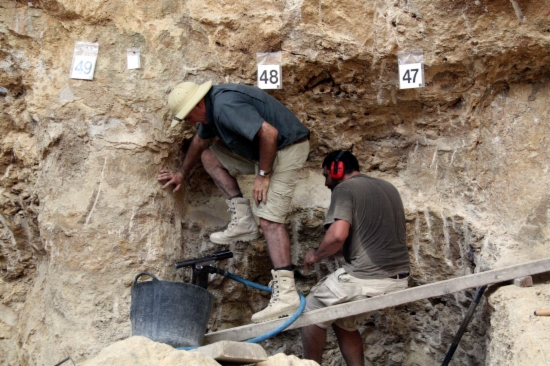Neanderthal’s period of greater expansion to be discovered at Catalan archaeological site Abric Romaní
The archaeological site known as Abric Romaní is currently being excavated for the 31st year in order to continue documenting and understanding how Neanderthals lived and organised communities in the north-eastern Iberian Peninsula. The archaeologist, palaeontologist and Director of excavations, Eudald Carbonell, has explained to the CNA that this campaign will be “very interesting” as the dig will be in the level corresponding to the time when the Neanderthals lived “their maximum expansion period”. Carbonell, who is one of the directors of Atapuerca site (where the Homo Antecessor was discovered), leads a team of 20 including research staff and doctoral students. The site is located some 50 kilometres west of Barcelona city and is open for the public to visit.

Barcelona (ACN).- This August, an excavation is taking place in an archaeological site near Barcelona (in Capellades) that was previously inhabited by Neanderthals. The site, known as Abric Romaní, is currently being excavated in order to understand and document how Neanderthals lived and organised their communities in the north-eastern part of the Iberian Peninsula. The archaeologist, palaeontologist and Director of excavations, Eudald Carbonell, has explained to the CNA that this dig will be “very interesting” as it takes place in the level corresponding to the time the Neanderthals lived “their maximum expansion period”, the era when they grew in size and influence. The Abric Romaní is a cave located in a cliff in the Cingles del Capelló, located some 50 kilometres west of the city of Barcelona. It has been a Palaeolithic archaeological site since 1983 when excavations began, although it was first discovered in 1909. This will be the 31st dig that has taken place on the site and several of the previous campaigns have been led by Carbonell, who is the Director of the Catalan Institute of Human Paleoecology and Social Evolution (IPHES). Carbonell is also one of the three co-directors of the Atapuerca site, where Europe’s oldest humanoid – Homo Antecessor – was discovered. This year’s dig in Abric Romaní began on the 8th of August; it will last until the 30th and members of the public are able to visit for free.
Neanderthals “were a very revolutionised society”
According to Carbonell, this year’s objective is to reach the excavation at level P, which is 55,000 years old, and then continue until level Q, which is between 56,000 and 58,000 years old. By doing this, “we will be able to obtain new data on the survival strategies and the ways which Neanderthals, who inhabited the north-eastern part of the Iberian Peninsula, organised their communities”, explained Carbonell. They also aim to get “new information to reconstruct the lives of these human groups in Europe”, he added. The archaeologist stated that the Neanderthals “were a very revolutionised society which had well established social networks divided into clans and tribes”. He believes that the extraction between level P and level Q will be very interesting as it “was the time when Neanderthals expanded the most”.
Thanks to the discoveries that are taking place and the good condition of the site it should be possible to construct an image of how these hunter-gatherers lived. Carbonell claimed that the dig will bring light to the Neanderthals employment and subsistence strategies, as well as what tools and weapons they used. The site’s Director also highlighted how the Abric Romaní is especially remarkable for the amount of fireplaces that have been found, which is a “very important element to explain how these humanoids organised their lives”. Furthermore, knives with handles made of flint have been found, “which shows how they were using refined technology”.
Visiting the archaeological site for free
Coinciding with the archaeological work that will take place until the 30th of August, the site will be open to the public with free admission. Visiting hours are between 11am until 1pm, and then from 5pm until 7pm. The dig involved a total of 20 people, the majority researches and students from the IPHES, which recently unveiled its new headquarters in Tarragona. The IPHES is one of the world’s most prestigious Palaeontology institutes, thanks to the research work undergone and digs such as the Abric Romaní and Atapuerca.